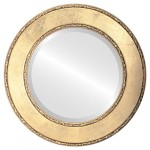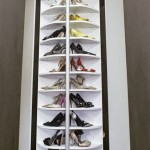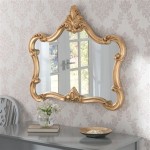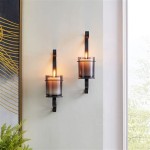How to Hang a Round Mirror Without a Wire
Hanging a round mirror can significantly enhance the aesthetic appeal of any room, adding depth, reflecting light, and serving as a stylish focal point. However, round mirrors frequently lack the traditional hanging wire found on rectangular or square mirrors, requiring alternative methods for secure and visually appealing installation. This article details several techniques to hang round mirrors without a wire, considering different wall types, mirror weights, and desired aesthetic outcomes.
Understanding Wall Types and Weight Limitations
Before commencing the hanging process, identifying the wall type is paramount. Common wall types include drywall, plaster, wood, brick, and concrete, each possessing varying load-bearing capacities. Drywall, the most prevalent wall type in modern homes, is relatively fragile and requires specialized anchors to support heavier mirrors. Plaster walls are more durable than drywall but can be prone to cracking if improperly handled. Wood, brick, and concrete offer significantly higher load-bearing capabilities but necessitate specific drilling techniques and hardware.
Mirror weight directly dictates the type and quantity of hardware required for secure installation. Lightweight mirrors, typically weighing under 10 pounds, can be supported by heavy-duty adhesive strips or small picture-hanging hooks. Medium-weight mirrors, ranging from 10 to 30 pounds, necessitate the use of drywall anchors or direct screwing into wall studs. Heavy mirrors, exceeding 30 pounds, demand professional installation or robust mounting solutions, such as steel brackets anchored directly into wall studs or concrete.
Failing to accurately assess wall type and mirror weight can result in the mirror falling, potentially causing damage to the mirror, the wall, and posing a safety hazard. Consulting with a hardware professional or contractor is advisable when dealing with unfamiliar wall types or heavy mirrors.
Methods for Hanging Round Mirrors Without a Wire
Several methods are available for hanging round mirrors that lack a pre-installed wire. The most suitable method depends on the mirror's weight, the wall type, and the desired aesthetic.
1. Using Heavy-Duty Adhesive Strips
Heavy-duty adhesive strips, specifically designed for picture and mirror hanging, offer a simple and non-invasive solution for lightweight mirrors (under 10 pounds) on smooth, clean surfaces. These strips typically utilize a strong adhesive on both sides, one adhering to the back of the mirror and the other to the wall. The key is to choose strips rated for a weight capacity exceeding the mirror's actual weight to ensure a secure hold.
Before applying the strips, thoroughly clean the back of the mirror and the wall surface with rubbing alcohol to remove any dust, grease, or debris that could compromise adhesion. Follow the manufacturer's instructions for strip placement, ensuring even distribution across the mirror's surface. Press the mirror firmly against the wall for the recommended duration, typically 30 seconds to one minute, allowing the adhesive to properly bond. Avoid repositioning the mirror after initial placement, as this can weaken the adhesive.
While convenient, adhesive strips are not suitable for heavier mirrors or textured walls, as the adhesive may not provide sufficient support. Additionally, removing adhesive strips can sometimes damage the wall surface, requiring patching and repainting.
2. Employing Mirror Mounting Clips and Brackets
Mirror mounting clips and brackets offer a more secure and versatile solution for hanging round mirrors of varying weights. These hardware options typically consist of two or more clips or brackets that attach to the wall and cradle the mirror's edge, providing support from below and/or the sides.
Several types of mirror mounting clips and brackets are available, including edge clips, bottom support clips, and J-channel brackets. Edge clips are small, discreet clips that grip the mirror's edge, providing minimal visibility. Bottom support clips offer enhanced support for heavier mirrors, typically placed at the bottom edge to bear the mirror's weight. J-channel brackets consist of a metal channel that runs along the bottom edge of the mirror, providing robust support and a clean, finished look.
Installation involves accurately measuring and marking the desired mirror position on the wall. Use a level to ensure the mirror will hang straight. Drill pilot holes into the wall according to the manufacturer's instructions, selecting appropriate drill bits and anchors for the wall type. Secure the clips or brackets to the wall using screws, ensuring they are tightly fastened and properly aligned. Carefully position the mirror into the clips or brackets, ensuring it is securely seated and level. For heavier mirrors, enlisting assistance to lift and position the mirror is advisable.
The key to successful installation lies in accurate measurements, proper anchor selection, and secure fastening of the clips or brackets. For heavier mirrors, spacing the brackets closer together provides additional support and prevents sagging.
3. Utilizing a French Cleat System
A French cleat system offers a robust and versatile method for hanging heavier round mirrors, particularly those with a flat back surface. A French cleat consists of two interlocking pieces of wood or metal, each cut at a 45-degree angle. One piece is attached to the back of the mirror, and the other is mounted to the wall. The angled design allows the cleat on the mirror to slot securely onto the cleat on the wall, distributing the weight evenly across the entire length of the cleat.
To install a French cleat, begin by securely attaching one cleat to the back of the mirror using construction adhesive and screws. Ensure the cleat is centered and flush with the mirror's edge. Allow the adhesive to fully cure before proceeding. Measure and mark the desired mirror position on the wall, using a level to ensure accuracy. Locate wall studs and attach the other cleat to the wall, aligning it with the marked position. Use screws long enough to penetrate the wall studs, providing a secure hold. If studs are not available, use appropriate drywall anchors rated for the mirror's weight.
Once both cleats are securely attached, carefully lift the mirror and slot the cleat on the mirror onto the cleat on the wall. The angled design will lock the mirror in place, providing a strong and stable hanging solution. A French cleat system is particularly effective for heavier mirrors, as it distributes the weight across a larger surface area and provides a secure, concealed mounting system.
Addressing Specific Challenges
Hanging a round mirror without a wire can present unique challenges depending on the mirror's design and the wall conditions. The following considerations can help address these potential issues:
Uneven Wall Surfaces: If the wall surface is uneven or textured, using shims behind the mounting clips or brackets can help to level the mirror and ensure a flush fit. Shims are thin pieces of wood or plastic that can be inserted between the bracket and the wall to compensate for any irregularities.
Frameless Mirrors: Hanging frameless mirrors requires careful handling to avoid damaging the delicate edges. Using mirror mastic, a specialized adhesive formulated for bonding mirrors, in conjunction with mounting clips can provide a secure and visually appealing solution. Apply the mirror mastic to the back of the mirror, following the manufacturer's instructions, and then position the mirror into the clips, allowing the mastic to cure for the recommended duration.
Large, Heavy Mirrors: Hanging large, heavy mirrors is best left to professionals. Professional installers possess the expertise and equipment necessary to safely and securely mount heavy mirrors, ensuring proper weight distribution and preventing potential damage.
Rental Properties: In rental properties, minimizing wall damage is crucial. Adhesive strips or removable mounting hooks offer temporary hanging solutions that can be easily removed without leaving permanent marks. However, it is essential to verify the weight limits of these options and ensure they are suitable for the mirror's weight.
By carefully considering these factors and selecting the appropriate hanging method, round mirrors without wires can be safely and securely mounted, enhancing the aesthetic appeal of any space without compromising structural integrity.

3 Simple Ways To Hang A Mirror On Wall Without Nails Wikihow

Foolproof Hang Art Or Mirror With 2 Hole Hangers Porch Daydreamer

How To Hang A Heavy Mirror On Drywall Picture Solutions

How To Hang A Heavy Mirror Taskrabbit Blog

The Mirror Hanging Trick C R A F T

How To Hang A Mirror With Wire Pictures Wikihow

How To Hang A Heavy Mirror The Home Depot

How To Hang A Heavy Mirror With Pictures Wikihow

How To Hang A Large Or Heavy Mirror

How To Hang A Mirror With Wire Pictures Wikihow








